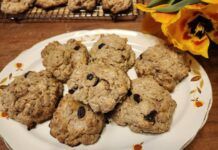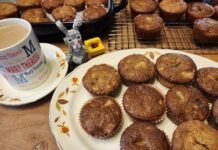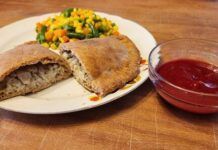Click here to subscribe today or Login.
Tuesday, February 02, 1999 Page: 1B
Focaccia: A simple, dimpled flatbread
Focaccia, the delicious, crunchy flatbread whose dimpled surface is often
made more fragrant with olive oil, crystals of sea salt and fresh herbs, is
fast becoming as popular as its northern Italian cousin, pizzaWhether painted
with tomatoes, dappled with cheeses or punctuated with olives, focaccia is
perfect anytime.
Foccacia is not a pizza dough but a simple flatbread that is served warm or
at room temperature but never piping hot. The versatile and simple dough is
much easier to make than bread dough. There is no twisting into complicated
shapes and it is easy to handle. And focaccia dough has an extremely nice
flavor and slightly porous texture.
The recipe below is for basic focaccia with fresh rosemary. Toppings are
only limited by your imagination. Some great toppings would include thinly
sliced potatoes, ribbons of sweet pepper or gorgonzola cheese with walnuts and
red onion.
Since focaccia could not exist without olive oil, it is usually served in a
small bowl on the side for dipping.
Basic focaccia
Yields: 1 11×17-inch focaccia
SPONGE
1 teaspoon active dry yeast
1/2 cup warm water (105 to 115 degrees)
3/4 cup unbleached all purpose flour
DOUGH
1 teaspoon active dry yeast
1 cup warm water (105 to 115 degrees)
3 tablespoons extra virgin olive oil sponge (above)
3 1/4 cups unbleached all purpose flour
2 teaspoons sea salt
TOPPING
2 tablespoons extra virgin olive oil
1 teaspoon sea salt
1 tablespoon fresh rosemary leaves
1. The “sponge” of this recipe is used to give an added boost to the rising
of the dough. To ~make the sponge, sprinkle the yeast over the warm water in
large mixing bowl. Whisk it in and let stand until creamy, about 10 minutes.
Stir in the flour and mix well. Cover tightly with plastic wrap and let rise
until very bubbly, 45 minutes.
(Some hints: Check the water temperature with a small thermometer.
Unbleached flour will provide better structure for the focaccia than bleached
flour. Spring water is best to use for taste. If you are using a heavy duty
mixer, make the sponge in the mixer’s mixing bowl. Set the rising bowl of
dough on the refrigerator or on a high shelf so it will be in the heat that
rises to the top of a room in winter time.)
2. To make the dough, sprinkle the yeast over the warm water in a small
bowl and whisk in. Let stand until creamy, about 5 minutes. With a wooden
spoon stir this yeast mixture, along with the olive oil, into the sponge of
step 1. Mix well. Stir in one cup of flour, the salt and mix. Then mix the
remaining flour until the dough is well blended. Knead on a lightly floured
surface until soft and velvety. This should take about 8 to 10 minutes.
(Some more hints: After the salt and the last of the flour have been added
and mixed for 1 minute, change to the dough hook and knead at medium speed
until the dough is soft, velvety and slightly sticky. This should take about 3
to 4 minutes).
Flour your work surface and knead the dough until it “comes together.”
3. For the first rising, place the dough in a lightly oiled container,
cover with plastic wrap and let rise until doubled. This should take about 1
1/4 hours.
4. For the shaping and second rise, flatten the dough on a well-oiled 11 by
17 inch baking sheet. Press it out with oiled or wet hands. Because the dough
is sticky and springs back, it may not cover the bottom of the pan. Cover the
pressed dough with a towel and let it rest about 10 minutes. Then press it
again until it covers the edges. Cover with a towel and let it rise for about
45 to 60 minutes. Just before baking, dimple the dough vigorously with your
knuckles to make indentations in it. Drizzle the olive oil over the top of the
dough making sure some of the oil pools in the indentations. Sprinkle with sea
salt and rosemary.
5. Bake at 425 degrees for 20-25 minutes or until the crust is crisp and
the top is golden. If you are using a pizza stone, remember to heat it up for
about 20 minutes before placing the pan on it. For the last 5 minutes, place
the focaccia directly on the stone for crispness. If you bake the foccacia on
a sheet pan, place it in middle of the oven. And Give the oven a blast of
water from a spritzer bottle immediately before baking. This gives the surface
of the focaccia that extra chewy crust. Be careful, however, not to spray
directly at the element. Spray the sides and either the top or bottom of the
oven, which ever doesn’t have an element.
Mark O’Malia is a food production specialist for the ARAMARK Corp. A
certified executive chef, he is also a graduate of the Culinary Institute of
America in Hyde Park and a member of the Professional Chefs of Northeastern
Pennsylvania.







